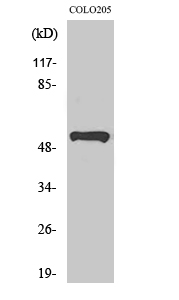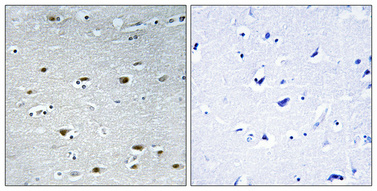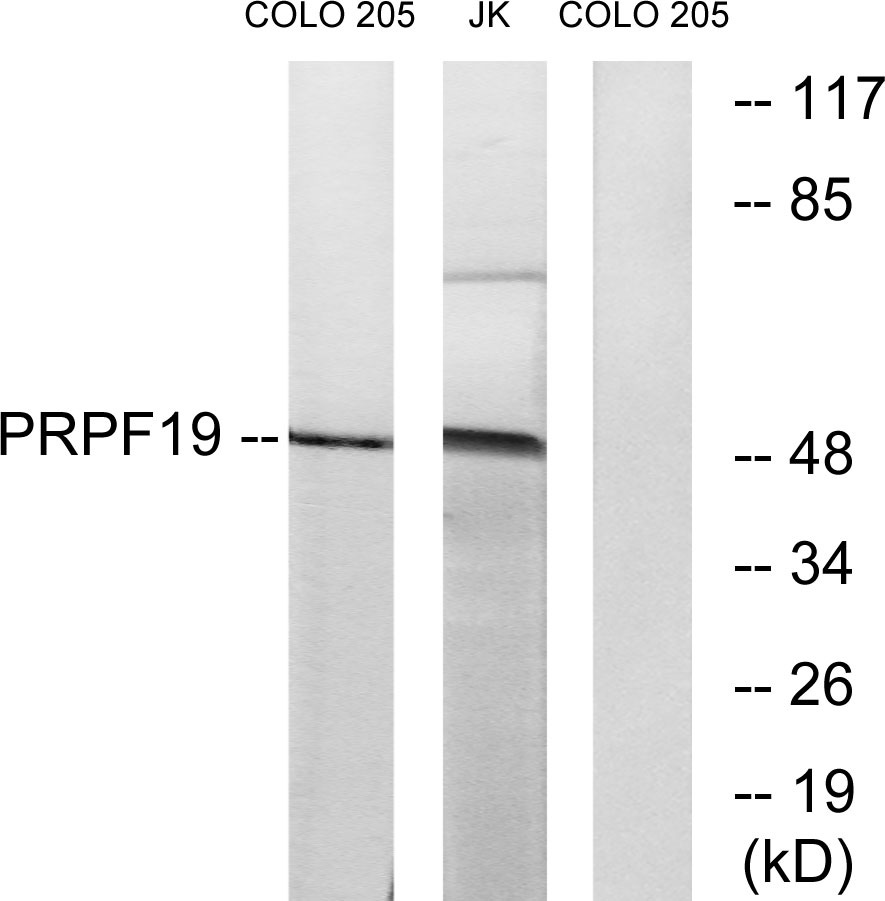PRP19 Polyclonal Antibody
- Catalog No.:YT3864
- Applications:WB;IHC;IF;ELISA
- Reactivity:Human;Mouse;Rat
- Target:
- PRP19
- Fields:
- >>Spliceosome;>>Ubiquitin mediated proteolysis
- Gene Name:
- PRPF19
- Protein Name:
- Pre-mRNA-processing factor 19
- Human Gene Id:
- 27339
- Human Swiss Prot No:
- Q9UMS4
- Mouse Gene Id:
- 28000
- Mouse Swiss Prot No:
- Q99KP6
- Rat Gene Id:
- 246216
- Rat Swiss Prot No:
- Q9JMJ4
- Immunogen:
- The antiserum was produced against synthesized peptide derived from human PRPF19. AA range:171-220
- Specificity:
- PRP19 Polyclonal Antibody detects endogenous levels of PRP19 protein.
- Formulation:
- Liquid in PBS containing 50% glycerol, 0.5% BSA and 0.02% sodium azide.
- Source:
- Polyclonal, Rabbit,IgG
- Dilution:
- WB 1:500 - 1:2000. IHC 1:100 - 1:300. ELISA: 1:40000.. IF 1:50-200
- Purification:
- The antibody was affinity-purified from rabbit antiserum by affinity-chromatography using epitope-specific immunogen.
- Concentration:
- 1 mg/ml
- Storage Stability:
- -15°C to -25°C/1 year(Do not lower than -25°C)
- Other Name:
- PRPF19;NMP200;PRP19;SNEV;Pre-mRNA-processing factor 19;Nuclear matrix protein 200;PRP19/PSO4 homolog;hPso4;Senescence evasion factor
- Observed Band(KD):
- 50kD
- Background:
- PSO4 is the human homolog of yeast Pso4, a gene essential for cell survival and DNA repair (Beck et al., 2008 [PubMed 18263876]).[supplied by OMIM, Sep 2008],
- Function:
- function:Plays a role in DNA double-strand break (DSB) repair and pre-mRNA splicing reaction. Binds double-stranded DNA in a sequence-nonspecific manner. Acts as a structural component of the nuclear framework. May also serve as a support for spliceosome binding and activity. Essential for spliceosome assembly in a oligomerization-dependent manner and might also be important for spliceosome stability. May have E3 ubiquitin ligase activity. The PSO4 complex is required in the DNA interstrand cross-links (ICLs) repair process. Overexpression of PRPF19 might extend the cellular life span by increasing the resistance to stress or by improving the DNA repair capacity of the cells.,induction:By gamma radiation and chemical mutagens but not by UV treatment.,similarity:Belongs to the WD repeat PRP19 family.,similarity:Contains 1 U-box domain.,similarity:Contains 7 WD repeats.,subcellular locatio
- Subcellular Location:
- Nucleus . Nucleus, nucleoplasm . Cytoplasm, cytoskeleton, spindle . Cytoplasm . Lipid droplet . Nucleoplasmic in interphase cells. Irregularly distributed in anaphase cells. In prophase cells, uniformly distributed, but not associated with condensing chromosomes. Found in extrachromosomal regions in metaphase cells. Mainly localized to the mitotic spindle apparatus when chromosomes segregate during anaphase. When nuclei reform during late telophase, uniformly distributed in daughter cells and displays no preferred association with decondensing chromatin. Recruited on damaged DNA at sites of double-strand break. .
- Expression:
- Ubiquitous. Weakly expressed in senescent cells of different tissue origins. Highly expressed in tumor cell lines.
- June 19-2018
- WESTERN IMMUNOBLOTTING PROTOCOL
- June 19-2018
- IMMUNOHISTOCHEMISTRY-PARAFFIN PROTOCOL
- June 19-2018
- IMMUNOFLUORESCENCE PROTOCOL
- September 08-2020
- FLOW-CYTOMEYRT-PROTOCOL
- May 20-2022
- Cell-Based ELISA│解您多样本WB检测之困扰
- July 13-2018
- CELL-BASED-ELISA-PROTOCOL-FOR-ACETYL-PROTEIN
- July 13-2018
- CELL-BASED-ELISA-PROTOCOL-FOR-PHOSPHO-PROTEIN
- July 13-2018
- Antibody-FAQs
- Products Images

- Western Blot analysis of various cells using PRP19 Polyclonal Antibody

- Immunohistochemical analysis of paraffin-embedded Human brain. Antibody was diluted at 1:100(4° overnight). High-pressure and temperature Tris-EDTA,pH8.0 was used for antigen retrieval. Negetive contrl (right) obtaned from antibody was pre-absorbed by immunogen peptide.

- Western blot analysis of lysates from COLO and Jurkat cells, using PRPF19 Antibody. The lane on the right is blocked with the synthesized peptide.



